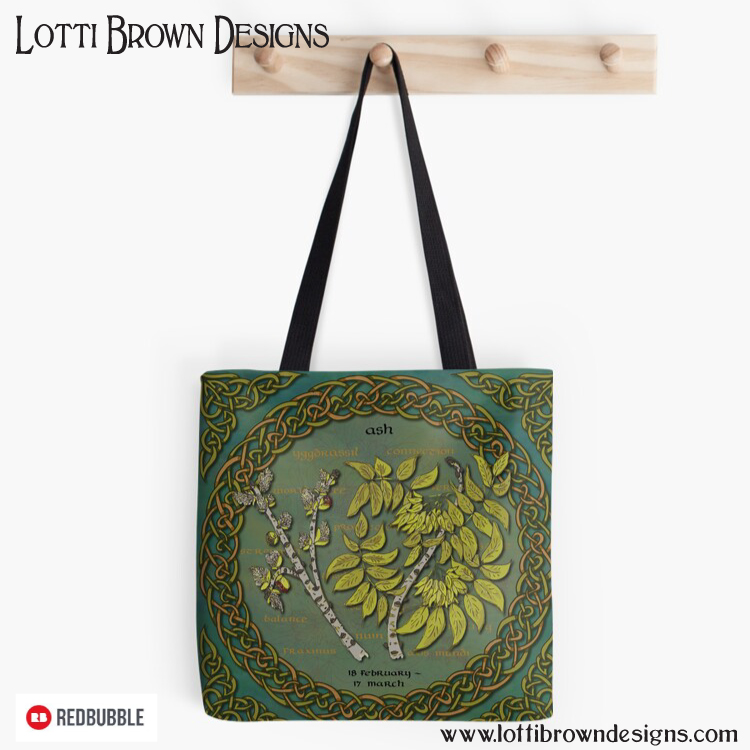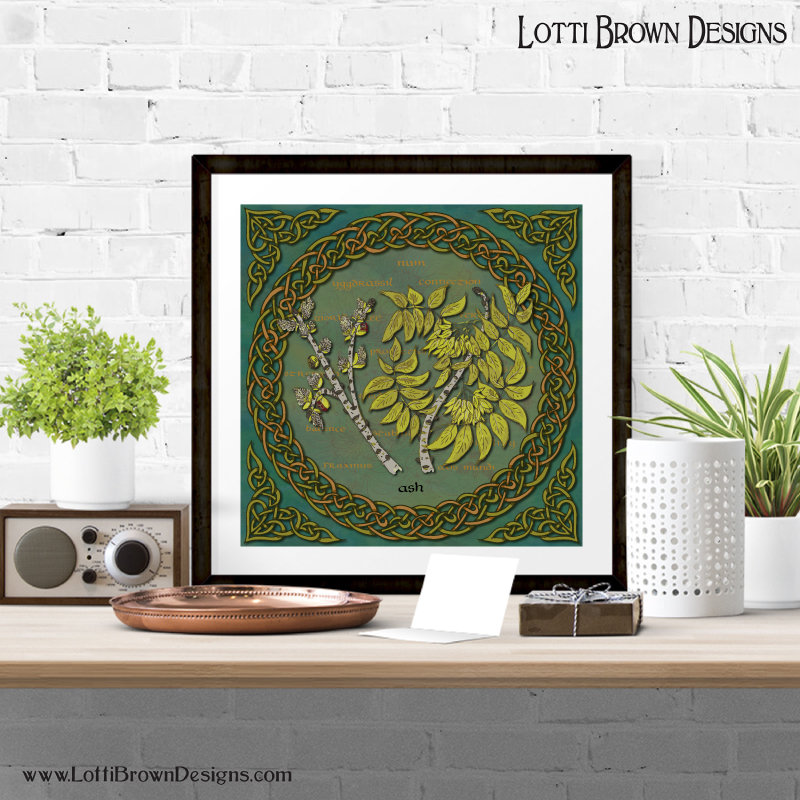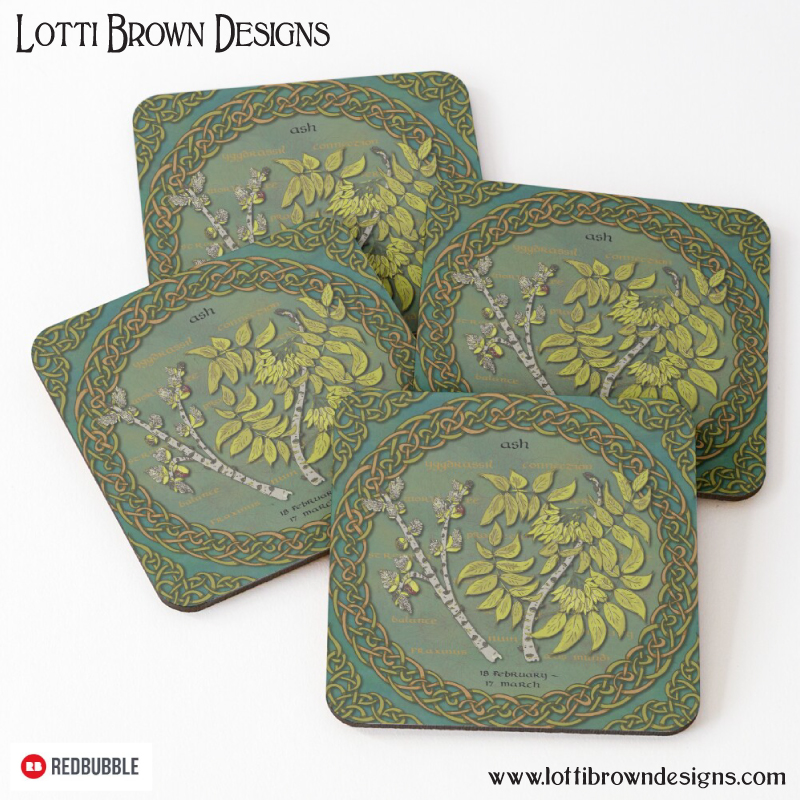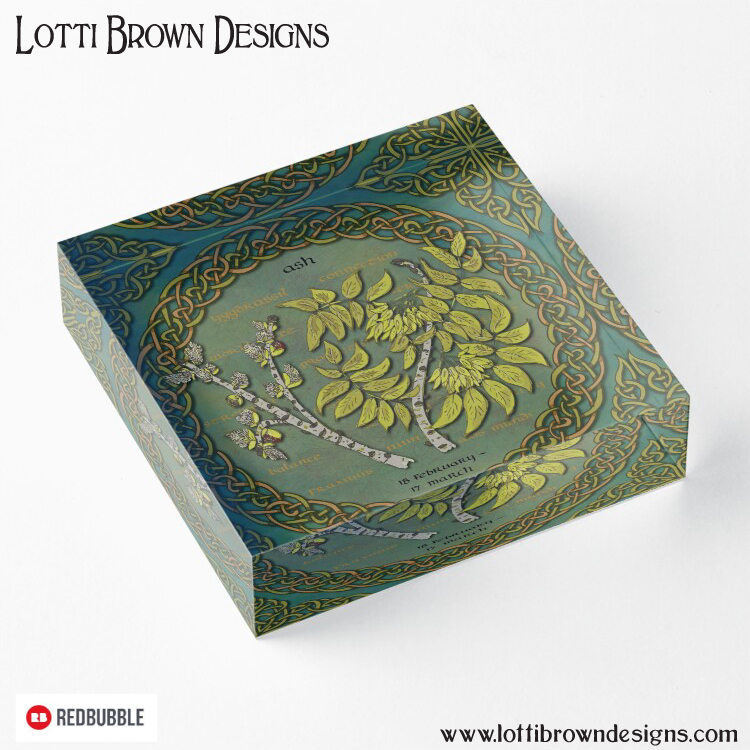*** IMPORTANT - I'm retiring my digital files - SVG/PNG/DXF/EPS - and printables from 31st December 2025 ***
*** Please ensure that you have everything you need - files and/or instructions printed off from the website (find them currently in the ARCHIVES section) - by 31st December 2025 as they will not be available after this date ***

Celtic Symbolism of Ash Tree
- Home
- Art - Living Archives
- Celtic Tree Art
- Ash Tree Symbolism
Celtic symbolism of Ash tree, myth, meaning and art...
Ash is one of our mightiest trees – a huge physical specimen when mature, but also a tree with some of the most impressive myth, meaning and folklore around it. So let’s explore and get to know one of our native British trees a little better…
This is part of my Celtic Tree Calendar art project, where I've been exploring the symbolism and meaning behind the trees of the Celtic Tree Calendar while creating artwork for each tree...
Wondering what the Celtic Tree Calendar actually is? Find out here...
 Celtic Ash Tree art by Lotti Brown
Celtic Ash Tree art by Lotti BrownCeltic Tree Calendar - Ash Tree: 18 February to 17 March
- Latin name: Fraxinus
- Irish/Gaelic name: Nuin
- Common names: esh, eshen tree, hoop ash, skedge, Hampshire weed – names for ash fruit ‘keys’: wings, ash candles, boots-and-shoes, cats-and-keys, cat’s keys, cattikeyns, chat, esh-keys, pattikeys.
- Language of Flowers meaning: grandeur
- Qualities: balance, stability, strength, protection, connection, vitality, fertility, justice, wisdom, connection
- Associations: World Tree, Yggdrassil, Odin, Woden, Norns, Nemesis, Andrasteia, Andraste, Achilles, spear, lightning, rain, thunderstorms, Thor, Yule log, shew-ash, husbandry
The World Tree
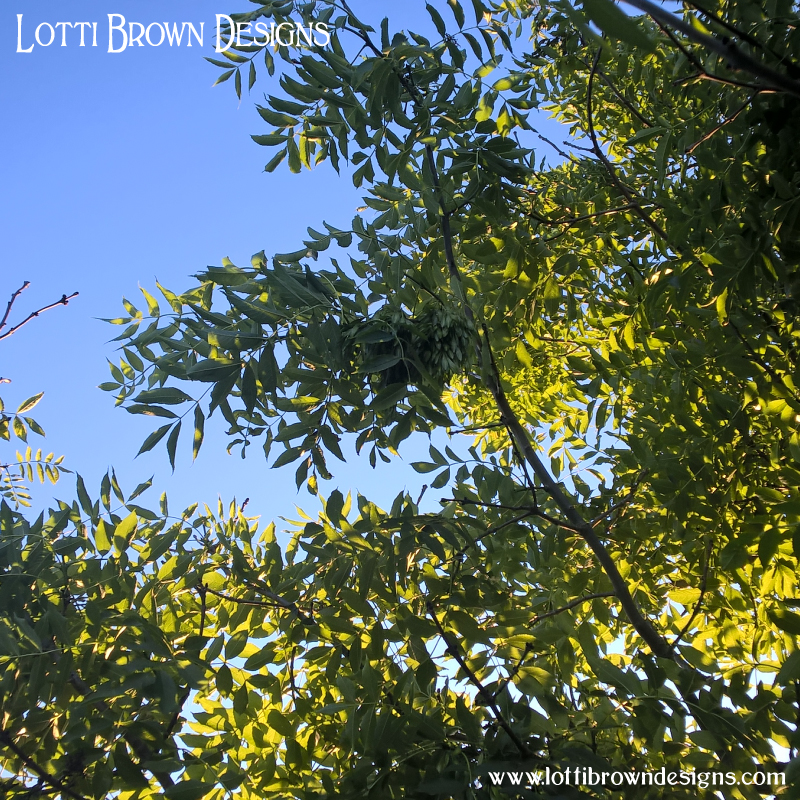 Ash tree branch
Ash tree branchIn the Scandinavian Creation myth, Odin turned two tree trunks which he’d found on the seashore into the first man or woman. The man’s trunk was ash. It’s said that this man and woman sheltered in the World Tree over the harsh winter and were sustained by its life-giving liquid. In Spring, they went forward to repopulate the earth.
This World Tree was the mythical Yggdrassil, an almighty ash tree that joined together the heavenly realms in its branches, the earthly realms in its trunk, and the realms of the underworld through its roots.
The World Tree was seen as the central pivot around which all life turns and upon which all life depends – the ‘axis mundi’. The World Tree was the steed of Odin that allowed him to travel to all realms.
The leaves of Yggdrassil were always green. An eagle lived in its branches, a serpent or dragon at its roots, a squirrel ran up and down the trunk, and four deer lived in and ate its branches, while a divine goat ate the leaves and thus produced the drink of the gods.
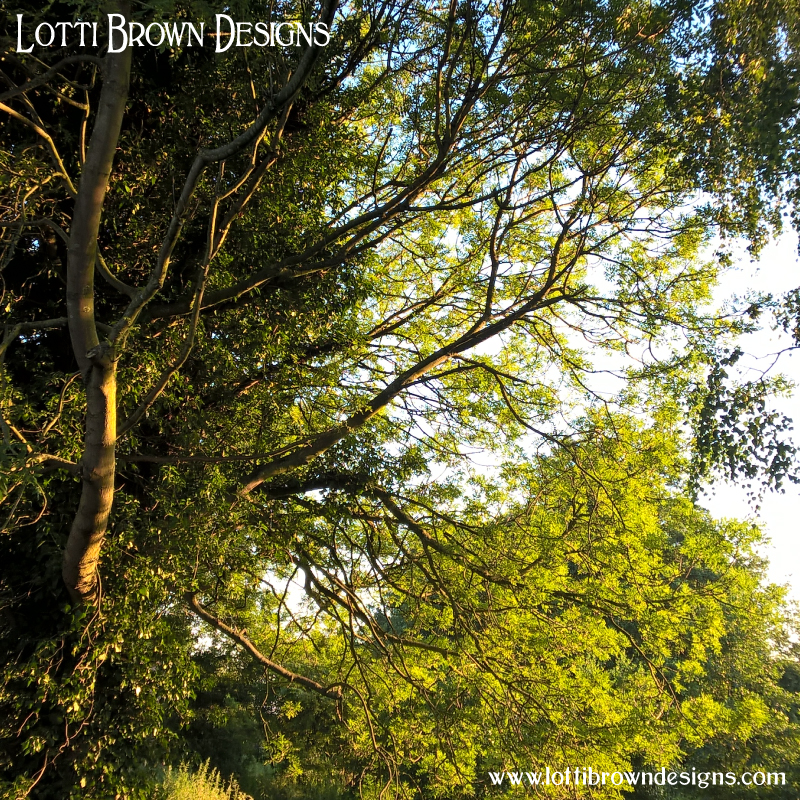 Ash tree
Ash treeSouls are born in the branches of Yggdrassil and the tree shakes when the end of the world threatens. Yggdrassil survives the end of one universe and is present through the forming of a new one.
The fountain of wisdom formed at the roots of Yggdrassil, also a spring which fed all streams on earth. This spring is the spring of fate, guarded by the oracle Mimir. In Germanic tradition, the World Tree was known as the tree of Mimir.
The Norse god of war Odin hung himself for nine days from the World Tree with a spear in his side, in order to be able to gain the hidden knowledge of the tree to aid mankind. Odin became the Anglo-Saxon god Woden, who gave his name to our Wednesday.
The gods met every day under the tree to pass judgements on mankind, a theme which we’ll come back to in just a second…
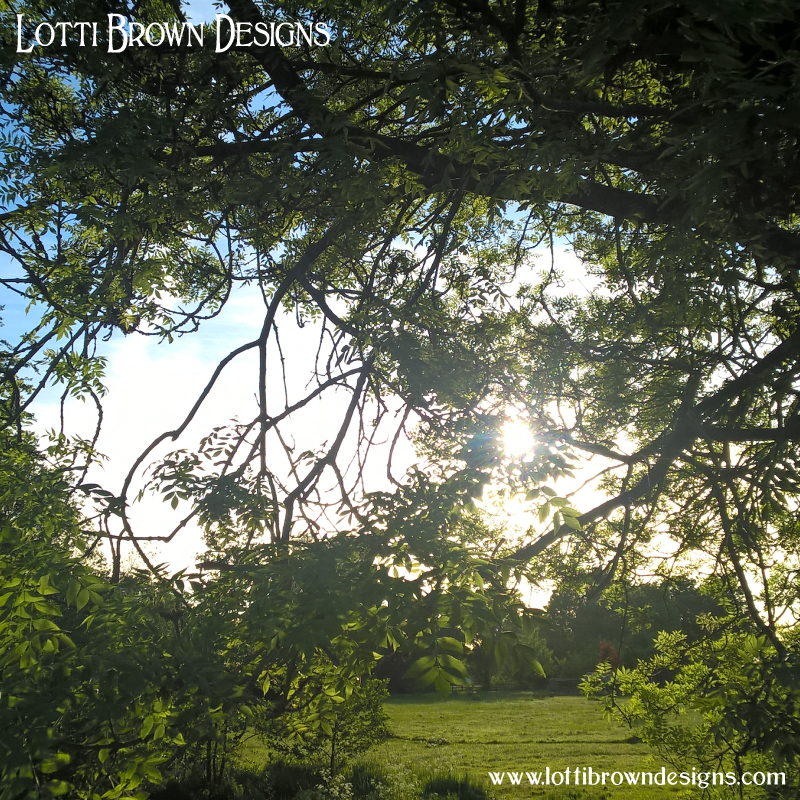 Ash tree
Ash treeTree of Fate
The guardians of Yggdrassil were the ‘Norns’ – three goddesses who ruled over the fate of mankind (sometimes called the ‘fates’ or ‘furies’). They were called ‘Urdr’ meaning ‘fate’, ‘Verdandi’ meaning ‘being’, and ‘Skuld’ meaning ‘necessity’.
The Norns watered and tended to the tree and covered its bark with clay to protect it. They also gave the (burnt) fruit of the tree to women in childbirth and so are associated with childbirth too.
The Norns are believed to be similar to the Greek goddess ‘Nemesis’ – a goddess of fate, she carried an ash branch to represent her role as an instrument of divine justice. Nemesis was tasked with ensuring that justice, happiness, and good fortune were evenly distributed amongst mankind. She could take good fortune away from one who kept their own fortune selfishly.
One of Nemesis’s symbols is the wheel, representing the solar wheel of the year and seasonal change.
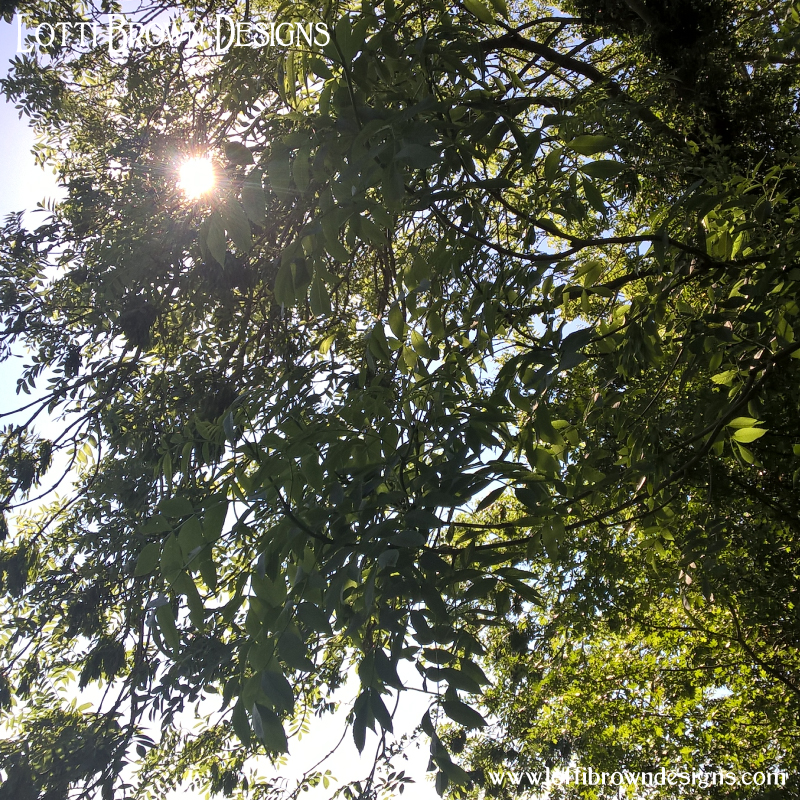 Ash tree
Ash treeTree of Rain
The Greek goddess ‘Andrasteia’ is known as ‘Nemesis of the rain-making ash tree’. Her symbols were also a wheel, an ash branch, and a scourge. She was the daughter of the god Oceanus and was an ash-nymph who brought life-giving rain to crops in the spring. She used her ash branch to flog crops and trees in order to bring the essential springtime fertility.
It’s thought that the Celtic goddess ‘Andraste’ could be a Celtic version of the Greek Andrasteia.
Ash is very much associated with rain and water, especially with thunderstorms and their associated downpours. Thor, the god of thunder had a spear of ash. It’s thought that the tall height of the ash tree may attract lightning.
A country rhyme tells us:
“Avoid an ash, for it courts a flash”
While its association with wet weather is recognised in the old weather lore:
“Ash before the oak,
We shall surely get a soak,
Oak before the ash,
We shall only get a splash”
The Greek god of the sea and storms, Poseidon, was also associated with the ash tree.
Tree of War
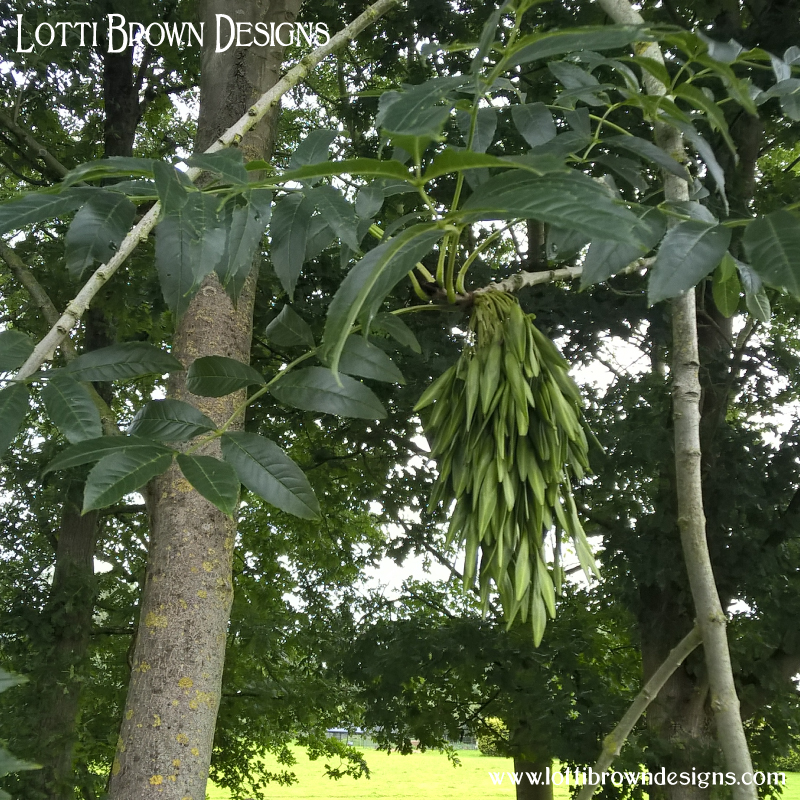 Ash tree with 'keys'
Ash tree with 'keys'And ash was also sacred to the Greek god of war, Ares. And the god Achilles received an ashen spear to go to war when he reached manhood, handed down from his father, Peleus, who was given the ash spear when he married Thetis.
On Achilles’s death, the spear became the talisman that allowed the bearer to pass freely to and from the underworld.
The Norse god Odin also has a spear of ash called ‘Gungnir’ – Odin is known as the ‘spear brandisher’ and uses his spear to induce battle frenzies and provoke warfare.
The symbol of the spear is very much associated with the ash. The Old English name for ash is ‘aesc’ meaning ‘spear’ and the Latin name for ash also means spear, ‘fraxinus’.
The Celts used ash to make their spear shafts which were treated as treasured objects and often decorated with carvings and even given a name.
Ash has also historically been used to make staffs or staves. An early Iron Age find on the Isle of Anglesey in Wales was a staff of ash with a ribbon of copper spiralling around it, thought to be a druid’s staff.
A Sacred Tree
Like the birch, the ash is often the tree used for the May Day maypole, which perhaps echoes the ‘axis mundi’ central world tree.
It’s also the wood traditionally used for witches’ broomstick handles (birch for the brush).
In the Celtic world were five sacred living trees in Ireland which were considered as world trees. Three of these were ash trees:
- Bile Tortan – the sacred tree of Tortiu
- Bile Usneg – the sacred tree of Usnech
- Craeb Dath – the bushy tree of Dathi
These trees were associated with the druid lifestyle and it’s said they were felled as Christianity came to Ireland.
The ash continued to be respected though and it was taboo to cut or injure the tree and traditions around the ash abounded…
 Ash tree
Ash treeEven in the 19th century, Irish emigrants to America took twigs from the ash-tree descendent of the sacred ash tree of Creevna to protect them from drowning. And sailors would carry an equal-armed ash cross to offer protection from storms. Non-sailors also believed these ash crosses could protect them from storms and would bring good health.
The ash was often the Yule log – feted and decorated as it was brought into the home, farmstead, or inn, fed mead or wine and then burnt on the hearth with the charred remains kept as kindling for next year’s Yule log. The ashes of the Yule log were often used to protect the home from lightning.
‘Ashen-faggots’ were often used instead of a Yule log of South-West England – a bundle of ash twigs tied with nine green-ash withies. The ashen-faggot arrived drawn by four oxen and with a great deal of ceremony. Unmarried girls would choose a withy and watched carefully as the faggot burnt to see whose withy burnt first as she would be the first to marry.
A Burning Tree
It was believed to be very lucky to have an ash tree outside your door – and ash was good for burning too:
“Ash when green
Is fuel for a queen”
Romany gypsies burned ash as they believed that the infant Jesus was bathed by the warmth of an ash-twig fire.
In Scotland, ash sap was given to new babies. An ash twig was placed with one end in the fire – as the sap or juice bubbled up, it was placed in the baby’s mouth or rubbed on their body to give good health.
Tree of Protection
Ash was also believed to protect from snakes. A Christian belief was that the ash was the only tree in the Garden of Eden unaffected by serpents.
And it was believed that a branch from an ash tree could kill an adder with one single blow. Drawing a circle with an ash stick around a snake would trap it inside the circle – nor could a snake cross ash leaves.
In Wales, ash was believed ‘a spite against snakes’ - and in Somerset, the household and animals were protected from snakes by hanging a special wreath on the ash tree nearest the house.
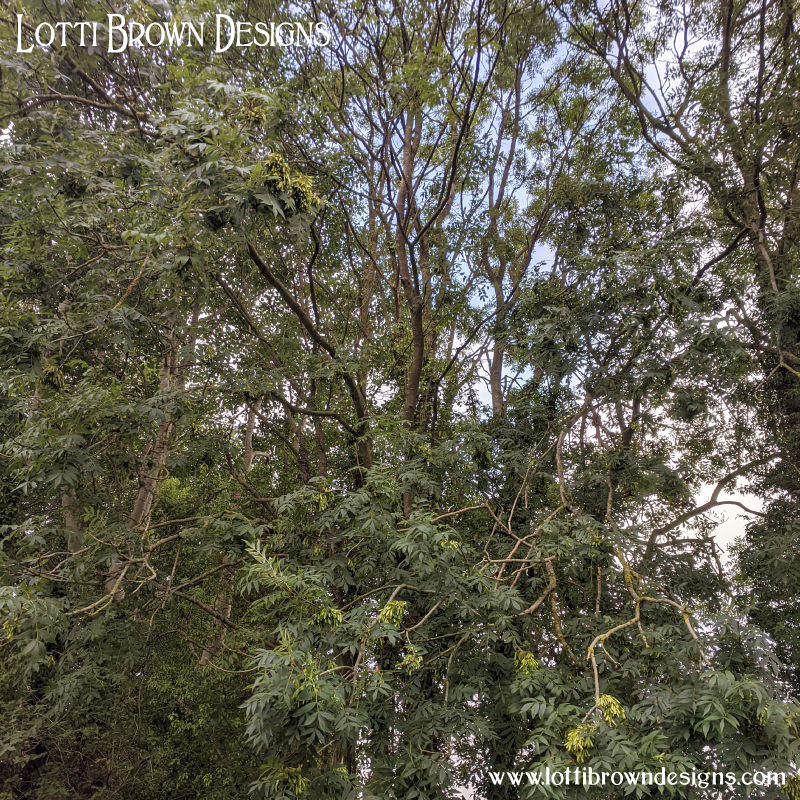 Ash tree
Ash treeIt was believed that a milk pail and churn-staff of ash wood would protect milk and butter from being bewitched.
Similarly, ash was seen to be protective of the farm animals. Whips of ash were used on horses and cows to save them from spells, while it was said that a horse would not be injured by a whip or stick of ash. In Yorkshire, carters tied ash leaves to their horses’ bridles to protect them from magic – and also flies!
Tree of Healing
As well as being protective, ash was also a healing tree. Warts could be pricked with a pin and then the pin stuck into the ash tree with the incantation:
“Ashen tree, Ashen tree,
Pray buy these warts off me”
Locks of hair were also sometimes pinned to the tree for long-distance cures for whooping cough.
Ash bark was used to help cure fevers and itchy scalp. The dried leaves were used for rheumatism and as a laxative and diuretic. The root of the ash, too, could be taken for rheumatic arthritis and to help diseases of the liver.
A chip of ash bark, taken at the precise moment that the sun entered the sign of Taurus could cure a nosebleed – a cure that’s recorded to have successfully cured King James II in Salisbury, in 1688.
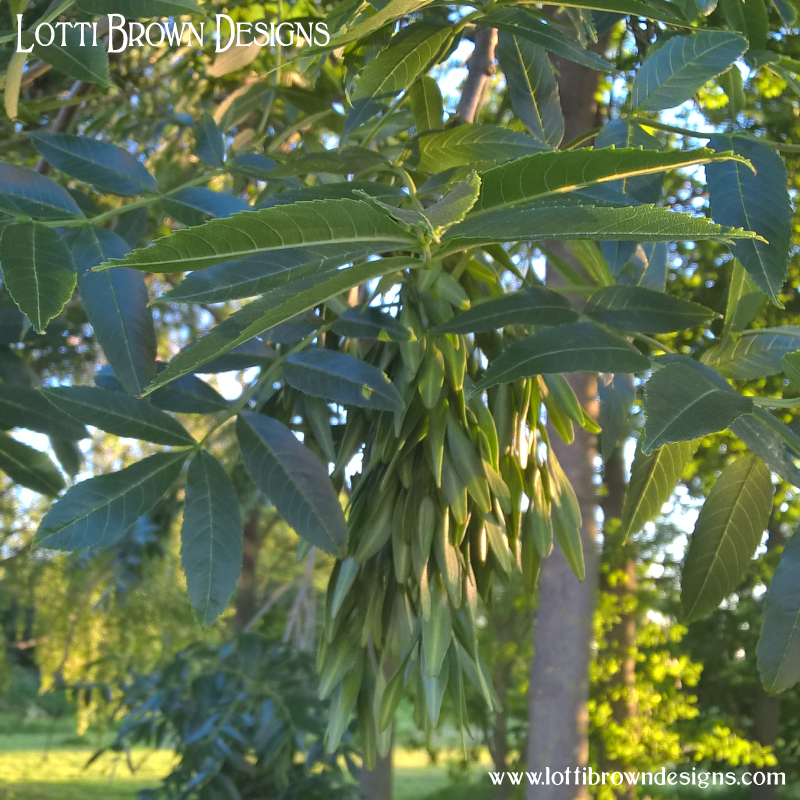 Ash tree leaves and 'keys'
Ash tree leaves and 'keys'Sufferers of ‘ague’ would often consult a woodsman about their symptoms. When the patient left, the woodsman would cut the first branch of a maiden ash, and as the cut was made, the patient would feel relief.
It was also common to cut or split a young ash tree down the centre of the trunk and an ailing baby would be passed through the split before the tree was bound up to heal – as the tree healed, so would the child.
Ash trees were also used to create healing ‘shrew-ash’ trees. In this cure, a tiny living shrew was walled up inside the ash tree, thus imbuing the tree with a healing power. Twigs and leaves from the tree were then used to heal humans and cattle.
Tree of Life and Love
The fruit or seeds of the ash tree, known as ash keys, were said to foretell the fortunes of the British royal family. No ash tree in England bore keys in 1648, the year before Charles I was executed – so an autumn with no ash keys is said to foreshadow a death in the royal family.
Old folk songs put the oak, ash, and hawthorn together. The oak is the male force, the hawthorn the female, and the ash as the life-giving energy that links the two.
Ash keys were also seen as a potent aphrodisiac, ‘provoking lust and make men more spirited with the ladies’. Decaying ash wood was also used as an aphrodisiac.
The ash key was also imbued with magical power – if you inserted an ash key in just the right place in the ash trunk, the tree would reveal its hidden knowledge to you.
The leaves of the ash tree were used for love spells, too. To find an ‘even ash’ was considered very lucky – this is an ash leaf with an even-numbered amount of leaflets on the leaf (a rare find).
“Even ash, I do thee pluck
Hoping thus to meet good luck
If no luck I get from thee
I shall wish thee on the tree”
As well as good luck, an even-ash lead could bring true love…
“If you find an even-ash or a four-leaved clover,
You will see your true love ‘ere the day is over.”
A young girl would take the even-ash leaf and and sleep with it under her pillow to dream of her true love – or she could put it in her glove:
“The even ash leaf in my glove,
The first I meet shall be my love.”
 Branches and leaves of an ash tree
Branches and leaves of an ash treeThe ash tree was sometimes known as the ‘husbandry tree’ or ‘husbandman’s tree’ because of its fast-growing, strong, and flexible wood. Ash is resistant to pests and diseases and an ash joint has greater weight-bearing properties than any other wood. It was used for wagons, coracles and oars, coaches, fencing, poles, tools, furniture, bows, arrows, and walking sticks.
Meaning and Symbolism of the Ash Tree
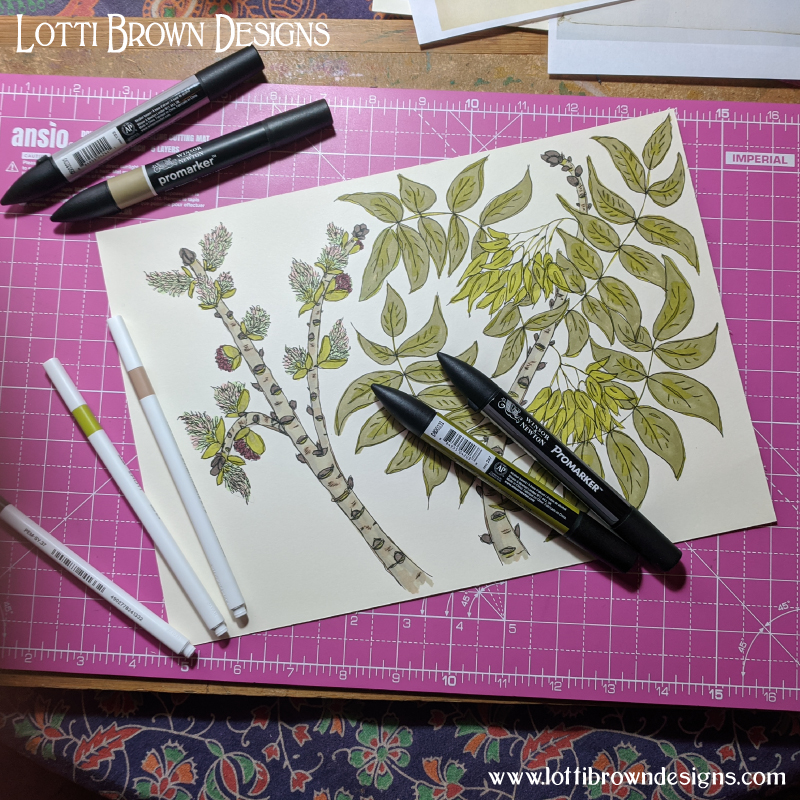 My ash drawings
My ash drawingsThe ash tree is about balance and stability. Its roots grow to the same size as its branches which means the tree is very stable and grounded with a good inner balance. As the World Tree, it provides balance between the earthly realm, the heavens, and the underworld.
Ash provides strength, endurance, and protects what we hold dear.
The ogham world for ash – ‘nuin’ – means strength or focus – the strength, focus and prowess of a young warrior – vitality, wisdom, courage and determination.
The tree is a symbol of connection, too – Yggdrassil connecting the separate realms of existence and forming an axis for the whole world.
It is justice, protection, and healing. It is life-giving rain and fertility in spring.
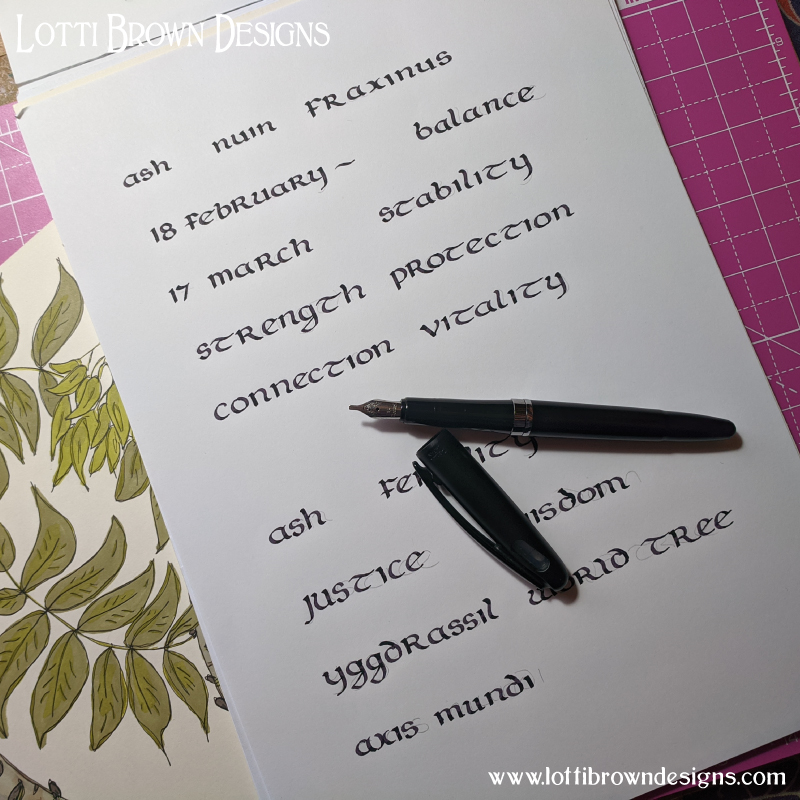 My calligraphy for the Ash tree - I incorporated this into my Ash Tree art below...
My calligraphy for the Ash tree - I incorporated this into my Ash Tree art below...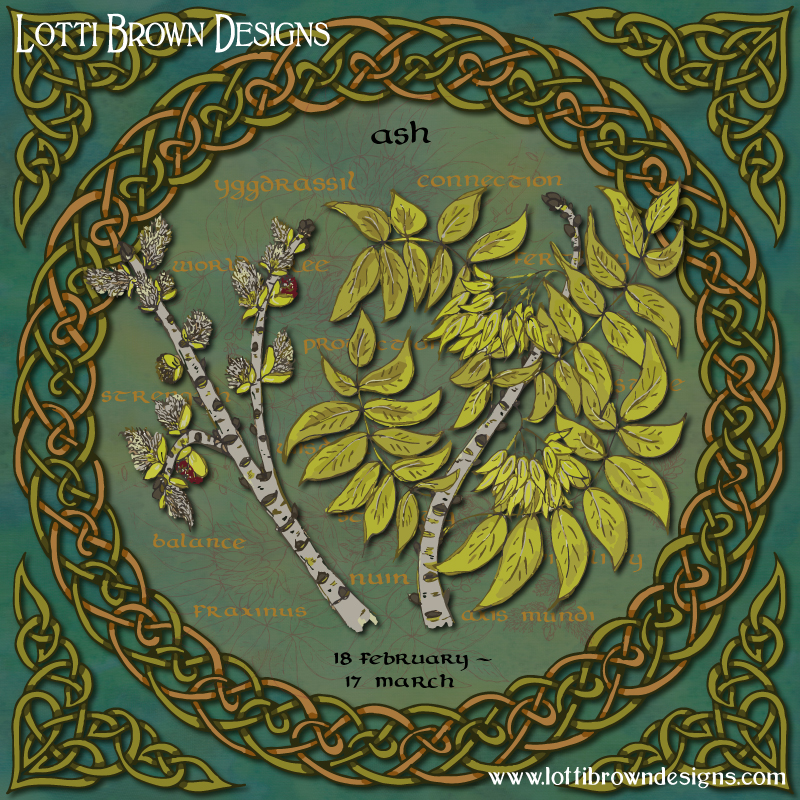 Celtic Tree Calendar Ash art by Lotti Brown
Celtic Tree Calendar Ash art by Lotti BrownMy Celtic Ash Tree Art
My Celtic Ash Tree art celebrates this amazing tree. I've actually created two versions of my Celtic Ash Tree art:
- the standard version (see below)
- a Celtic Tree Calendar version with dates added (18 February to 17 March) - see above - which correspond to the month for the ash - ideal for birthdays, anniversaries and other special occasions between these dates - learn about the Celtic Tree Calendar here...
You can buy both versions my Celtic Ash tree art as wall art prints and home products from my Redbubble store:
- wide variety of products including T-shirts, cushions, throws, shower curtains, mugs, phone/tech cases, clocks, pouches, bags and much more...
- fast international delivery from your closest manufacturing location
Just a small selection of the products available...
Browse all the products and prints for both versions below...
See all the other trees in my Celtic Tree Calendar art project here...
See all my Celtic artworks here...
Learn about the Celtic Tree Calendar here...
See all my earlier art here...
Discover more British nature folklore in my Folklore Hub here...
Explore my current art collections here!
Further Reading
- Celtic Tree Magic – D. Forest
- Tree Wisdom – J.M. Paterson
- Vickery’s Folk Flora – R. Vickery
- Discovering the Folklore of Plants – M. Baker
- Plant Lore and Legend – R. Binney
- Penguin Dictionary of Symbols
- Britain’s Tree Story – J. Hight
Please note that the information in this piece is for entertainment only and should not be used to diagnose or prescribe for health purposes.
Shall we stay in touch..?
Each month, I share stories from my own nature journal, new art from my studio, and simple seasonal inspiration to help you feel more connected with the turning year...
Recent Articles
-
British Nature Folklore Library: Stories, Seasons & Celtic Tree Wisdom
Dec 01, 25 05:09 AM
Explore British nature folklore, Celtic tree meanings, and seasonal wildlife stories. A growing library of myth, meaning, and hand-drawn inspiration. -
Beautiful Art Inspired by Nature
Dec 01, 25 05:04 AM
Beautiful folksy art inspired by nature from the fields and hedgerows of Yorkshire - colourful birds and wildlife with a nostalgic floral touch... -
Birds and Folklore in Britain: A November Nature Journal
Nov 26, 25 04:32 AM
November birds and berries - fieldfares, redwings, lapwings and snow geese with folklore, meaning and nature journal inspiration.
Follow me:
Share this page:

